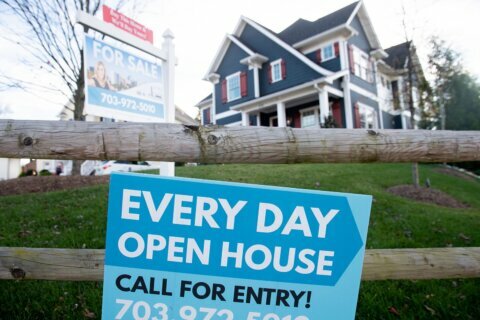If you’re hoping to buy a new home soon, you may be concerned about all of the hubbub surrounding tariffs.
It’s been a chaotic spring economically, as President Donald Trump in March imposed tariffs on imports from major international trade partners Canada, Mexico and China. On the heels of a major tariff escalation on April 9, Trump announced a 90-day pause on most import duties. While this sent the stock market into a tizzy, it also has many wondering about the impact on purchases big and small.
One of the biggest purchases people will make is a home. How much more expensive could a new home be if new tariffs are added to a range of imported goods? Here are some parts of a house that could become more expensive and how much it may cost you.
[READ: How to Do ‘For Sale by Owner’ the Right Way]
What Are Tariffs?
Tariffs are taxes charged on anything purchased from other countries. If a homebuilder in the United States buys lumber or steel from another country, a tariff will make those materials more expensive. That, at least in theory and often in practice, will be passed along in the cost of a new home.
Tariff Impacts on Lumber
A lot of wood for homes comes from Canada. “While the U.S. has increased its production of lumber over the past years, we still rely on Canadian lumber,” says Patricia Jordan, associate professor of professional practice in the information systems and supply chain management department at Texas Christian University’s Neeley School of Business. “Approximately 30% of lumber is imported from Canada.”
Jordan says construction companies would likely try to source more lumber from American companies, with mixed results. “The sawmills will more than likely not be able to absorb the cost of the new tariff amount, leading to higher prices,” she says.
Tariff Impacts on Gypsum
Gypsum is the key component in drywall, plaster and cement, so it will generally be in any new construction house.
“Gypsum is also imported from Canada, Mexico and China,” Jordan says, name-checking three countries the Trump administration has focused on.
Other countries produce a lot of gypsum, Jordan says, so builders have options. “Spain imports approximately 44% of the product,” she says. The pause on tariffs issued Wednesday will give European Union countries a reprieve but have no impact on goods imported from China, Mexico and Canada, according to the White House.
Tariff Impacts on Steel and Aluminum
Much of the steel and aluminum in homes comes from China, says Usha Haley, professor of international business and management at the Wichita State University Barton School of Business in Kansas. Tariffs on China make the cost of steel and aluminum from the country more costly. Builders were already spending around $4 billion a year, after the first 10% tariff, according to Haley, who believes the tariffs could take the collective cost of builders’ construction materials from China to north of $45 billion a year.
Canada is the largest steel exporter to the United States, and Mexico is third. So China’s steel is more expensive now, and soon, steel from Canada and Mexico may be. However, more than 180 countries import steel to the United States. So theoretically, a homebuilder could get steel elsewhere, or from the United States, to keep prices down. That may sound easier than it would be in practice. Most homebuilders have developed relationships with companies and countries and can’t always make immediate changes.
Builders will face significant financial pressure to pass the higher costs on to consumers, according to Pelin Pekgun, a business professor who studies supply chains and pricing at Wake Forest University’s School of Business in Winston-Salem, North Carolina.
Pekgun says some homebuilders may feel they have to scale back or delay projects if critical materials become too expensive or scarce. That, Pekgun says, could result “in slower construction and fewer homes on the market. Limited supply could then push prices even higher, intensifying affordability challenges.”
She says smaller homebuilders who work on thinner margins and have fewer resources could be in trouble. And if smaller homebuilders go out of business, that means fewer houses would be built. The lowered supply could create pressure, causing home prices to rise.
[READ: 21 Sustainable Building Materials to Consider for Your Home]
Tariff Impacts on Appliances and Flooring
Many appliances in new homes come from China, Haley points out. Whether your refrigerator or oven comes with your new house or you buy it on your own, those tariffs will add to your costs.
Patrick S. Duffy, U.S. News’ senior real estate economist, says that along with appliances, China makes a lot of the flooring for homes. If you like hardwood floors, for instance, that, too, will cost more.
Tariffs on food that comes from around the world could also make it more expensive to fill your refrigerator, new or old.
Tariff Impacts on the ‘Guts’ of the House
Heating and cooling systems, plumbing and electrical materials could also see tariffs applied, Jordan says.
These components form the “guts” of your home — and many are imported from Canada. The Canadian Institute of Plumbing and Heating and the Mechanical Contractors Association of Canada, advocating on behalf of the industry to the Canadian government, cited downstream effects of tariffs including added housing costs, increased operating budget costs for institutional construction and supply chain issues.
[READ: Heat Pump vs. Furnace: Which Home Heating System Is Best?]
Tariffs and Home Prices
Buying a home is already stressful, and the additional worry about tariffs can make it even more nerve-racking. It’s important to remember that nobody knows how this will all play out.
Even if the tariffs are resolved quickly, Pekgun says, “the uncertainty and dynamically shifting trade policies can still have a ripple effect on the housing market. When homebuilders, suppliers and buyers do not know what to expect, they often delay decisions, scale back investments or raise prices to hedge against future risks.”
It’s hard to say exactly how much lumber or any material will end up costing in the near or long-term future, Jordan says, because the cost to build a home “depends on many interrelated factors,” including how efficient a builder’s supply chain is, how much they can purchase raw materials for, how long the tariffs last and, Jordan says, how the consumer behaves.
Duffy seconds the thought about the consumer. “If people are feeling worried about keeping their jobs, maybe they aren’t going to buy a house,” he says. If fewer people are trying to purchase a home, that can affect the price of a home, perhaps making them more affordable for those who can purchase a house.
In fact, if a recession were to occur and push down home prices, Duffy says, if your job is stable and fewer people are in the market for a home, “it could be the perfect time for buy a house.”
Still, whatever happens, the price of your new home is likely to go up, and rising prices have already been hurting middle-class families. A December 2024 Primerica’s Financial Security Monitor report polled 1,085 adults nationwide from Dec. 20 to Dec. 23, 2024, and found that 65% of respondents said their income wasn’t keeping up with the cost of living.
Jordan says that with interest rates higher, “homebuyers have had to adapt to purchasing smaller homes, choosing simpler or most cost-effect finishes, or delaying upgrades.” Tariffs and rising prices in general may drive buyers to keep making these choices.
Haley predicts that tariffs will likely add more than $10,000 to the price of a home, “not including potential delays and supply chain disruptions.” She thinks more builders will likely depend on Mexico as “the most cost-effective source for materials, even with its existing 25% tariff, thanks to lower labor and transportation expenses.”
Duffy points out that other factors could drive up the cost of a home. He worries about labor. “A lot of immigrants work in construction. If they’re deported or even here legally but are scared to go to work because they don’t want to get inadvertently rounded up, that could have an impact,” Duffy says.
Many of these tariffs are designed to increase manufacturing in the United States and help American businesses and homeowners, and Haley says that it could eventually work out that way.
“Shifting gears to domestic products for construction is possible but will take time. The United States has over 300 billion trees but not the industrial capacity to meet housing demand within the next couple of years,” Haley says. And as long as homes can’t be built fast enough to keep up with demand, home prices aren’t likely to stop rising.
More from U.S. News
Can You Build a Fireproof Home?
What Kind of House Can You Buy for $1,500 a Month?
What Homebuyers Need to Know About Climate Change
How Will Trump’s Tariffs Affect Homebuyers? originally appeared on usnews.com
Update 02/10/25: A previous version of this story misattributed the poll in which 65% of respondents said their income wasn’t keeping up with the cost of living to the Primerica Household Budget Index. It was from Primerica’s Financial Security Monitor.
Update 04/10/25: This story was published at an earlier date and has been updated with new information.







